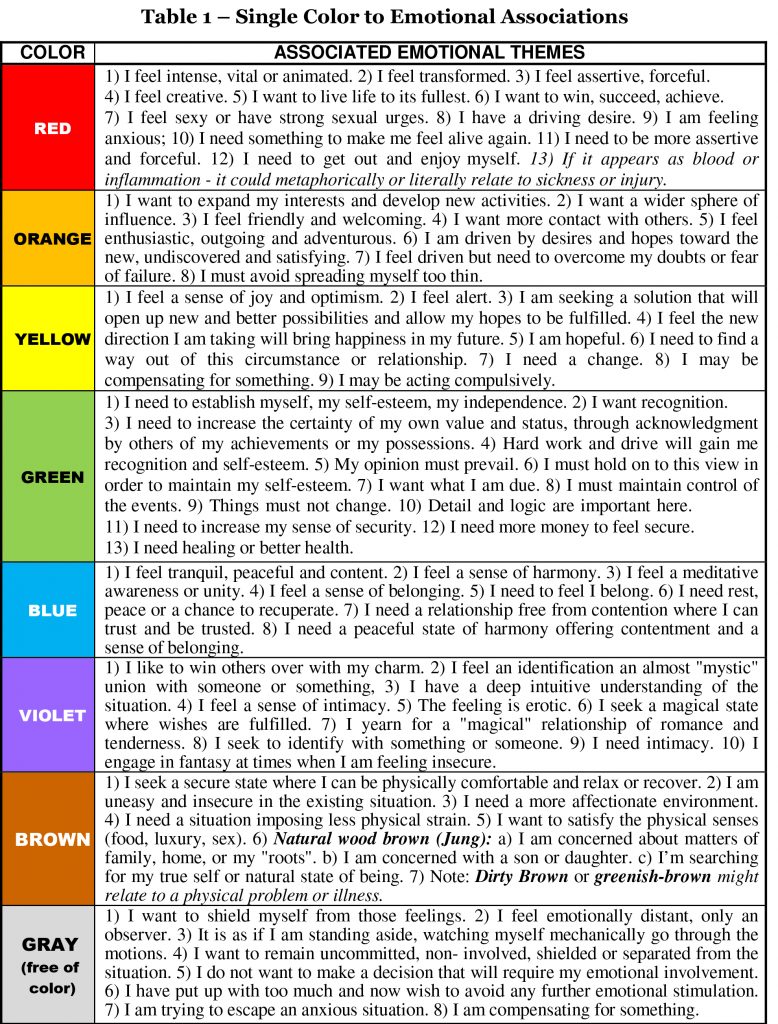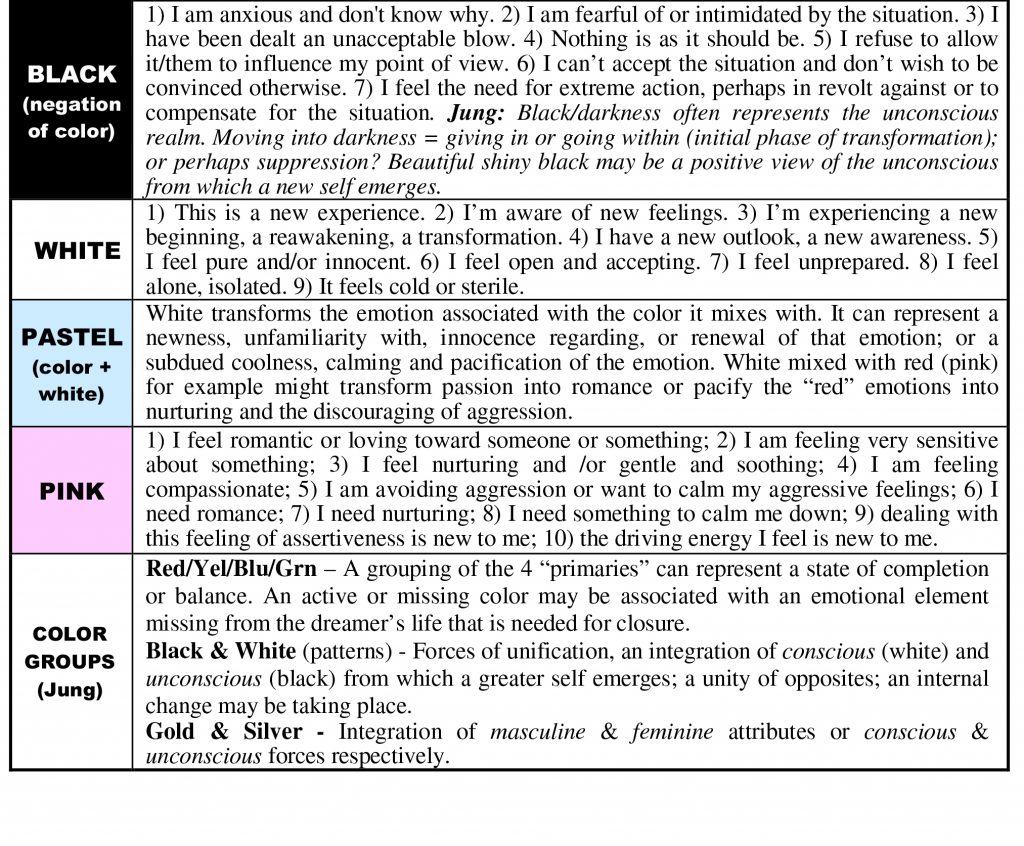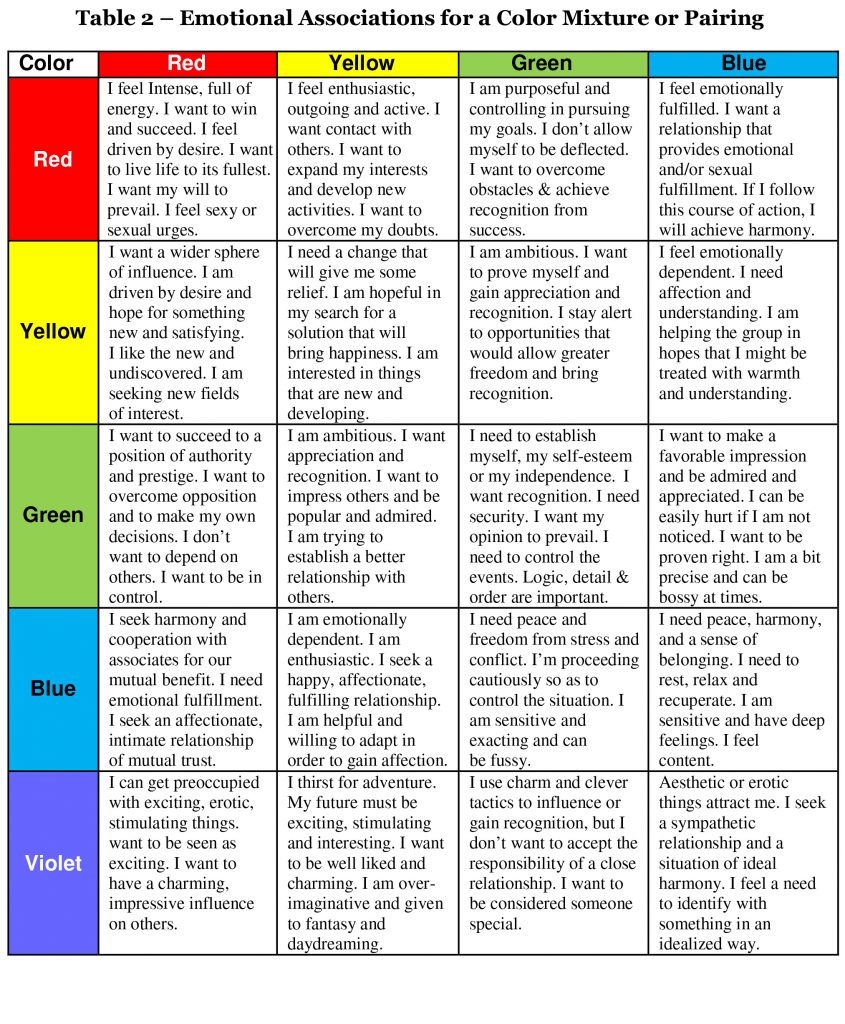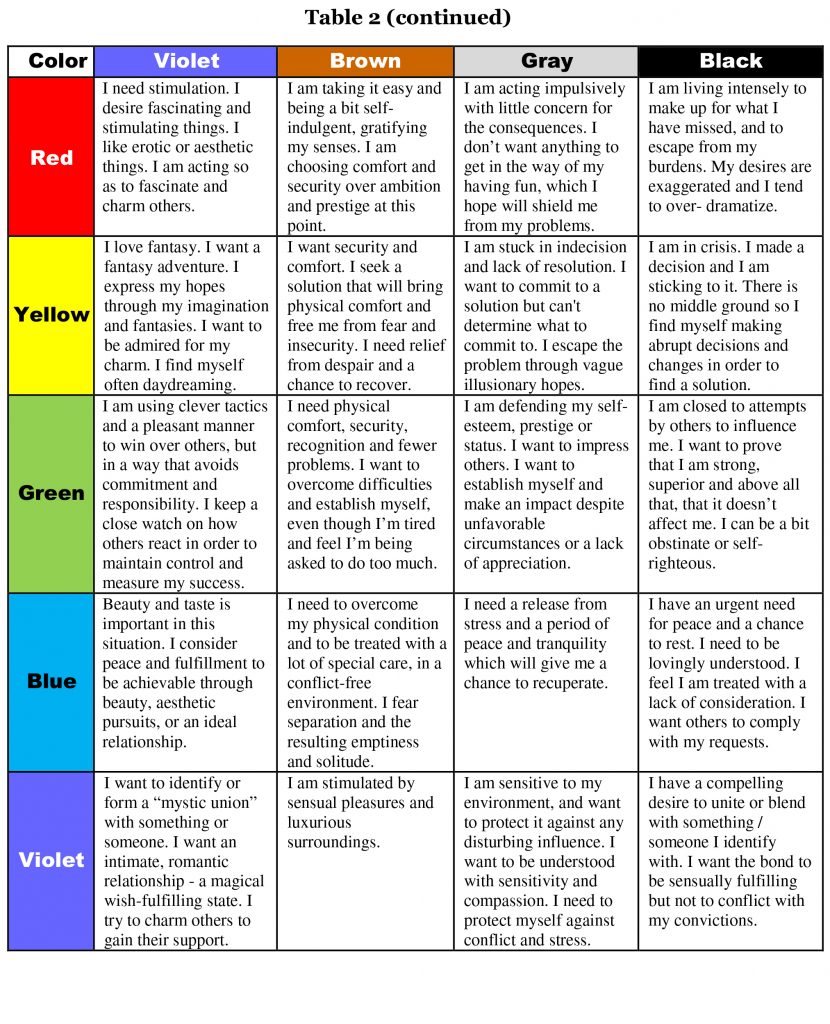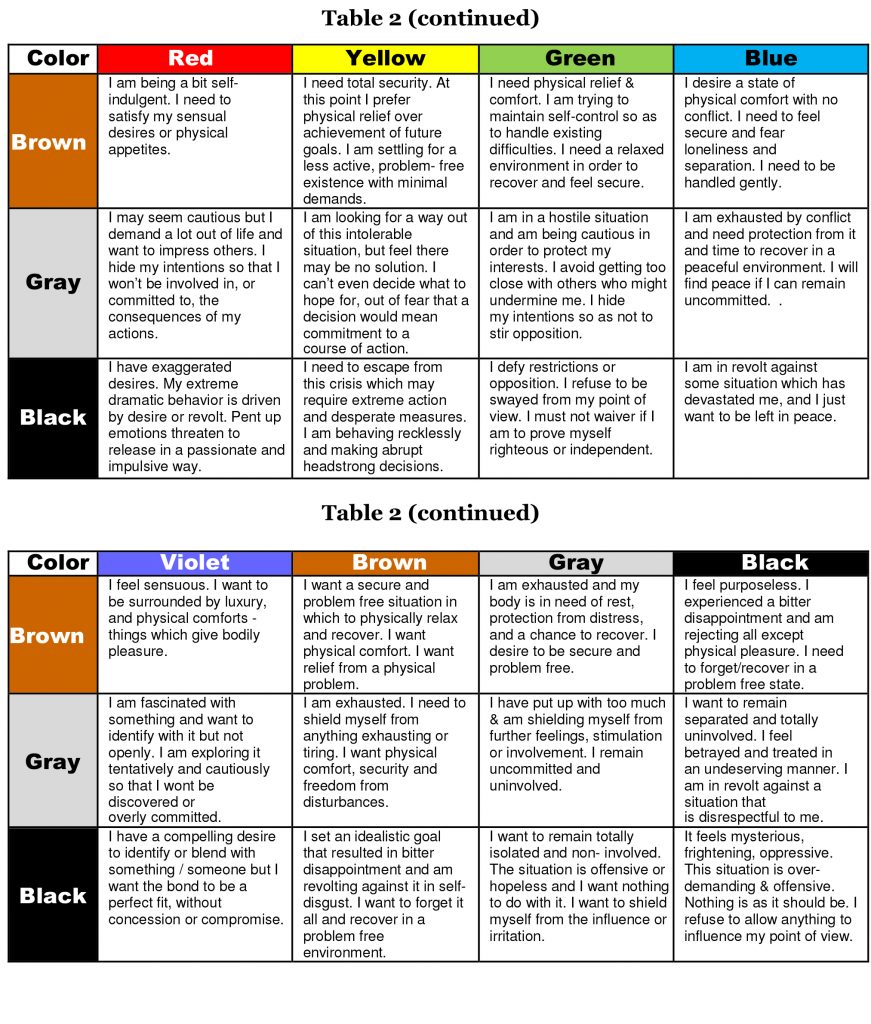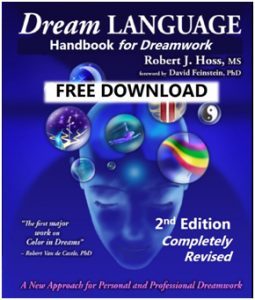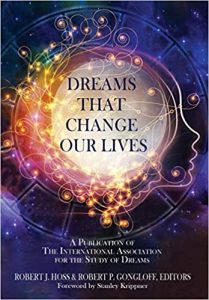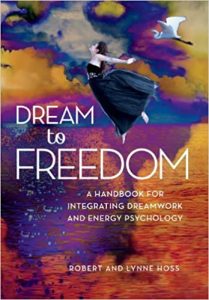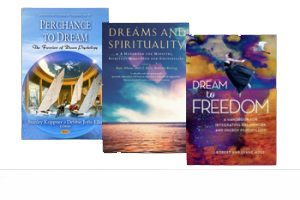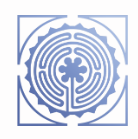Working with Color in Dreams by Robert J. Hoss, MS
Text and charts also below
- Part #3 Dream Color Contents
- Section 8 Do we Dream in Color …1
- Section 9 Theories: The Significance of Color …3
- Section 10 Dream Color Studies and Research… 5
- Section 11 The Color Questionnaire… 26
- References… 34
Other articles and presentations regarding Working with Color in Dreams
- The Dream Color Questionnaire in PDF
- Content Analysis on Color in Dreams, Hoss IJoDR 2010
- Color Reported in Dreams in the First and Second Half of the 20th Century: a Content Analysis
- The Significance of Color in Dreams Does Color Reflect Emotion?
INTRODUCTION
We dream in color! One of the surprising facts about dreaming is that most dreams appear to originate with some color content even though we rarely recall the color upon awakening. The myth that dreams are in black and white was perpetuated a decade or so prior to the discovery of REM in the early ‘50s, after which research methodology changed and dispelled that viewpoint. In laboratory settings when subjects are awakened during a REM stage of sleep, color is mentioned spontaneously in as much as 46% of dream reports, and if the subject is asked explicitly about color, the percentage of color recall increased to about 80% to 97.3%. (Schredl, 2008). Color recall, just as with any dream content, seems to be a function of memory and our attention to color as we report the dream, both of which seem to diminish rapidly after waking. This is suggested by the fact that color recall drops to about 11% to 29% in spontaneous dream reports (those remembered upon awaking and written down some time thereafter).
What does it mean to dream in color? It is curious that there has been little research done with color in dreams – not so much whether we dream in color, that is well researched, but what the individual colors represent. A search for the answer to this question led me to over a decade of research into the significance of color in dreams. I found color psychology research and literature (Lüscher, 1971, 1979; Birren, 1961, 1978; Brown, 1974; Ertel, 1973; Goldstein, 1942; Riley, 1995; Sutton & Whelan, 2004) to show that the human brain, limbic and autonomic nervous system responds physiologically and emotionally to various color illuminations – subliminally and in a fairly predictable manner likely due to evolutionary influences. Working in sessions with individual dreamers, I used personal databases and tools (such as Gestalt role-play) to reveal the emotional associations within a dream image. Comparing this to the color psychology findings, I was able to demonstrate that the same waking state color to emotional associations appear to carry over into the dream state (Hoss, 1999, 2005, 2010). Various color to emotional processing centers remain active in waking and REM sleep so this made sense. Working with very large dream databases I was further able to establish physiological and emotional response to influence dream color (Hoss, 2010).
In essence I discovered that dream color is a symbol (or imagery fragment) just like any other symbol, that combines (or condenses as Freud called it)with dream imagery to add additional “meaning” to the composite dream image (go to Color Research link or Dream Language 2nd Ed.). That “meaning”, although influenced by culture and personal experience, is for the most part emotional and based on our collective human subliminal response to individual colors. Color “paints our dreams with emotion” (quote from Reader’s Digest, 2006). The research also resulted in my development of the Color Questionnaire (below) which consolidates much of the common color-to-emotional human response information, in statements designed to trigger a person’s own emotional associations with a color. It is useful for research and dreamwork.
Working with Color: Color can be treated as any other dream image or symbol in a dream – representing associations that combine with dream images in order to complete the full “meaning” of that dream image – adding an emotional charge or essence to that image. As the studies described in the Dream Color Research download suggest – different colors represent clusters of different emotional associations. In the Psychology of Dreaming section we learned that dream imagery forms as a picture-metaphor representation of the dreamer’s feelings, emotional memories, and conceptualizations – the whole image being a condensation of linked associations. Color is one of those associations so working on a dream image, without paying attention to the color, would leave out a great deal of important information.
Robert Van De Castle once stated that the colored images we more readily recall in dreams may represent the more important or emotionally charged dream images – so work with the colors that stood out. Also since dream color carries over from waking life associations (the continuity hypothesis) when the whole dream is in color, again focus on the colors that stood out or choose the color of a dream image where the color can be optional (for example something like a red car or blue door where the color can be anything, as opposed to green grass or blue sky which are common for those elements).
COLOR QUESTIONNAIRE
ref: Bob Hoss MS, Dream Language, Innersource, 2005
About the Questionnaire:
Single Colors
Note that in table 1 the statements within each color represent an emotional theme that encompasses both the positive and negative aspects of a color association – both a sense of being filled with or feeling that emotion as well as needing that feeling or condition. Red, for example, can relate to feeling energetic as well as a need for more energy. Also note that the colors are named as pure hues.
Color Mixtures
As colors mix or blend with black and white and become darker or lighter, associations will change (Sutton & Whelan, 2004) which is one reason the questionnaire can only be used as a starting point to explore your own associations. Table 2 principally used Lüscher color pair themes as a reference and provides a means for exploring color mixtures or when a pairing of colors appears in a dream.
Pastels
Pastels are a mixing a primary color with white and thus might relate to the influence of white on that emotional state. White can represent the feelings of “newness” and therefore when mixing with another color might represent an emergence or re-emergence of the emotion associated with the color. Sutton and Whelan (2004) discuss the mixture of white with colors as related to a coolness or peacefulness, and associate many of the color combinations with white as a “cooling” of the color (and thus emotion) with which it mixes, making it less intense and more pleasant and friendly.
Color Pairs – Conflict vs. Integration
When working with dreams that contain an obvious pairing or juxtaposition of two colors, I have often found that the pair represents a conflict between the two emotional states associated with the two colors. Table 1 or table 2 can be used to explore the possible emotions involved in such a conflict. In table 1 read the statements for both colors noting whether any two statements that you connect with (one for each color) might represent two sides of a conflict you feel you are involved in. Table 2 can also be explored as it was designed around Lüscher Color Test themes which might capture the essence of a conflict.
Often, according to Jung, dreams can present a pairing of different images (and thus different colors) to represent an “integration of opposites” or in other words the intended state of balance or resolution. So, when using the color pair table 2, look at the statements that you connect with as also possibly relating to a potential path to, or desired state of, resolution.
Proper Use of the Questionnaire:
The statements do NOT represent the “meaning” of a dream color and should not be used as a dictionary of color meaning. It does not work that way. They contain emotional themes reportedly associated with color as found in various color psychology studies. The statements are designed to trigger your own personal associations with a situation the dream might be dealing with so use it as a questionnaire; as you read the statements ask yourself “does this sound like a way I have felt recently?”
The statements are variations around an emotional theme found to be associated with that color – a spectrum of emotions, from being “filled with the emotion,” to needing more of that emotional stimulus. You may find that only one or two statements within a color cell relate to your specific situation, whereas the others do not, or one may sound like your situation but not exactly as worded. This is exactly how it was designed. So, don’t depend totally on the tables for answers. They are intended only as an aid to trigger your own associations.
When working with the tables, pick the statement(s) that really stands out, that provides the greatest “aha” or connection with your waking life situation. Then set aside the table and use your own words to describe your situation and relate it to the dream story.
1) Select the colored dream images to work on: Work on the color of an image you have been working with in a dream and/or the color(s) that you feel most drawn to or that stand out. It is best to work with something that is not a commonly colored object (like green grass), unless it stands out. It is best to work with a colored image that could be any color (such as a red hat, a blue car, an orange dress). Also look for color pairing which might represent a conflict between emotions or an eventual integrated state of emotional resolution. Look for a grouping of the 4 primary colors – red, yellow, blue and green (or if one color seems to be most active in the group of 4 or is obviously missing from the group, work on that color).
2) Pick the color in table 1 that best matches the color of the dream image, or for a color mixture try table 2. Don’t worry if there is not a perfect match. The tables are not intended to reveal the “meaning” “of the color. They are only intended to trigger your own associations from the emotional themes represented.
- Single
Color: use table 1 to
select the closest matching color or
table 2 if it is a mixture of hues (example: rust/reddish-brown, blue-green,
etc.) In table 2 first match the dominant hue in the mix with the colors in the
rows, then match the secondary color in the columns.
- Color Pair: Explore the possibility that the two colors might represent conflicting emotions by using table 1 on each color separately or table 2 on the pair. Also use table 2 to explore the possibility that the pairing might represent an integration, a path to, or eventual state of, resolution. Pick the row with the dominant color, then select the secondary color from the column, and read the statements at the intersection of the two.
3) Read each statement as a question asking yourself: “Does this statement relate to a way I have felt recently or describe a situation in my waking life?” For color pairs, using tables 1 or 2, explore whether the two colors might represent two conflicted emotions or whether a statement in table 2 might represent a possible state of resolution.
4) Relate to Life: Pick the one or two statement(s) that create the strongest “aha” response or “connection,” that best relate to a waking life situation or conflict. Describe the situation, and the feelings at the time, in your own words. How does this add to your understanding of the situation the dream is dealing with?
